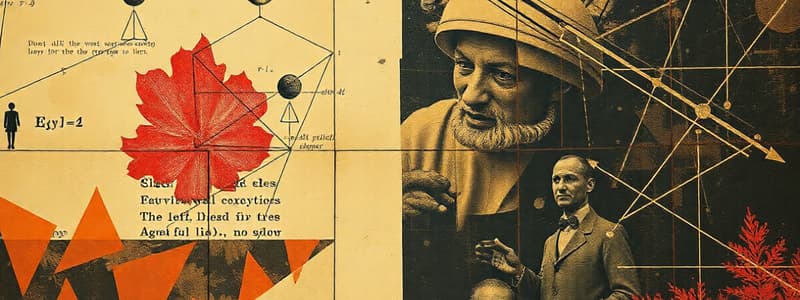Podcast
Questions and Answers
What describes the force between two point charges?
What describes the force between two point charges?
- It is inversely proportional to the product of the charges.
- It is directly proportional to the product of the charges. (correct)
- It is directly proportional to the square of the distance between them.
- It is independent of the distance between them.
Which of the following is a consequence of Gauss's Law for Magnetism?
Which of the following is a consequence of Gauss's Law for Magnetism?
- Increasing electric field strength reduces magnetic field strength.
- Magnetic field lines are closed loops. (correct)
- Electromagnetic waves can propagate through vacuum.
- Magnetic field lines must begin and end on magnetic monopoles.
What is the primary role of Faraday's Law of Induction?
What is the primary role of Faraday's Law of Induction?
- To characterize how a changing magnetic field induces an electric current. (correct)
- To explain how stationary electric charges produce magnetic fields.
- To quantify the force exerted between two moving electric charges.
- To describe the relationship between electric fields and magnetic fields.
In what application is the principle of electromagnetism most directly utilized?
In what application is the principle of electromagnetism most directly utilized?
Which principle is primarily applied in the development of electronic devices?
Which principle is primarily applied in the development of electronic devices?
How do electric motors primarily function?
How do electric motors primarily function?
Which area utilizes physics to study climate change?
Which area utilizes physics to study climate change?
What does Maxwell's Equations establish in electromagnetism?
What does Maxwell's Equations establish in electromagnetism?
Flashcards are hidden until you start studying
Study Notes
Electromagnetism
-
Definition: Branch of physics studying electric charges, magnetic fields, and the interaction between them.
-
Key Concepts:
- Electric Charge: Fundamental property of matter; exists as positive and negative charges.
- Coulomb's Law: Describes the force between two point charges; force is directly proportional to the product of the charges and inversely proportional to the square of the distance between them.
- Electric Field (E): Region around a charged object where forces are exerted on other charges.
- Magnetic Field (B): Region around a magnet or current-carrying conductor where magnetic forces are observed.
-
Maxwell's Equations:
- Set of four equations that form the foundation of electromagnetism.
- Gauss's Law for Electricity: Relates electric fields to electric charges.
- Gauss's Law for Magnetism: States there are no magnetic monopoles; magnetic field lines are closed loops.
- Faraday's Law of Induction: Describes how a changing magnetic field can induce an electric current.
- Ampère's Law: Relates magnetic fields to the electric currents that produce them.
- Set of four equations that form the foundation of electromagnetism.
-
Applications:
- Electromagnetic Waves: Radio waves, microwaves, visible light as a result of oscillating electric and magnetic fields.
- Electric Motors: Convert electrical energy into mechanical energy using magnetic fields.
- Transformers: Change voltage levels in alternating current circuits via electromagnetic induction.
Application of Physics
-
Definition: Utilization of physical principles to solve practical problems in various fields.
-
Key Areas:
- Engineering: Application of physics in designing structures, machines, and systems.
- Medicine: Use of physics in medical imaging (e.g., MRI, X-rays), radiation therapy, and understanding biomechanics.
- Technology: Development of electronic devices, communication systems, and materials science.
- Environmental Science: Physics principles in studying climate change, renewable energy, and pollutant dispersion.
-
Real-world Examples:
- Transportation: Understanding aerodynamics for vehicles and aircraft.
- Energy Production: Thermodynamics in power plants, and the principles of electromagnetism in generators.
- Nanotechnology: Physics at the nanoscale used to develop new materials and technologies.
-
Innovation and Research:
- Ongoing research in condensed matter physics, quantum mechanics, and plasma physics driving advancements in technology.
- Interdisciplinary approaches integrating physics with biology (biophysics), chemistry (physical chemistry), and computer science.
Electromagnetism
- Branch of physics dealing with electric charges, magnetic fields, and their interaction.
- Electric Charge: Fundamental property of matter with positive and negative charges.
- Coulomb's Law: Describes the force between two point charges, proportional to the product of the charges and inversely proportional to the square of their distance.
- Electric Field (E): Region surrounding a charged object where forces are exerted on other charges.
- Magnetic Field (B): Region surrounding a magnet or a current-carrying conductor where magnetic forces are observed.
- Maxwell's Equations: Four equations forming the foundation of electromagnetism.
- Gauss's Law for Electricity: Relates electric fields to electric charges.
- Gauss's Law for Magnetism: States magnetic fields are continuous loops.
- Faraday's Law of Induction: Describes how changing magnetic fields induce electric currents.
- Ampère's Law: Relates magnetic fields to electric currents that produce them.
Applications of Physics
- Engineering: Physics applied in designing structures, machines, and systems.
- Medicine: Physics used in medical imaging (e.g., MRI, X-rays), radiation therapy, and biomechanics.
- Technology: Development of electronic devices, communication systems, and materials science.
- Environmental Science: Physics principles in studying climate change, renewable energy, and pollutant dispersion.
- Transportation: Understanding aerodynamics for vehicles and aircraft.
- Energy Production: Thermodynamics in power plants, and electromagnetism in generators.
- Nanotechnology: Physics applied at the nanoscale to develop new materials and technologies.
- Innovation and Research: Continuous research in condensed matter physics, quantum mechanics, and plasma physics drives technological advancements.
- Interdisciplinary Approaches: Integration of physics with biology, chemistry, and computer science.
Studying That Suits You
Use AI to generate personalized quizzes and flashcards to suit your learning preferences.




